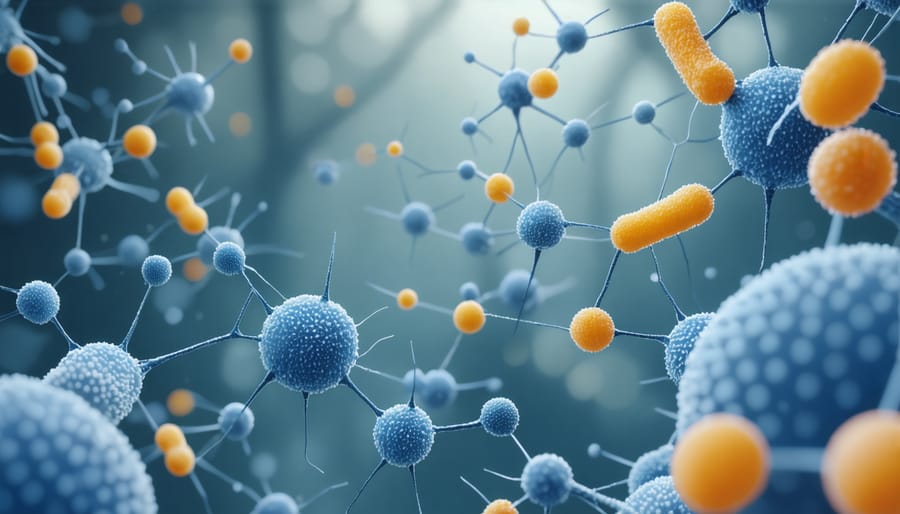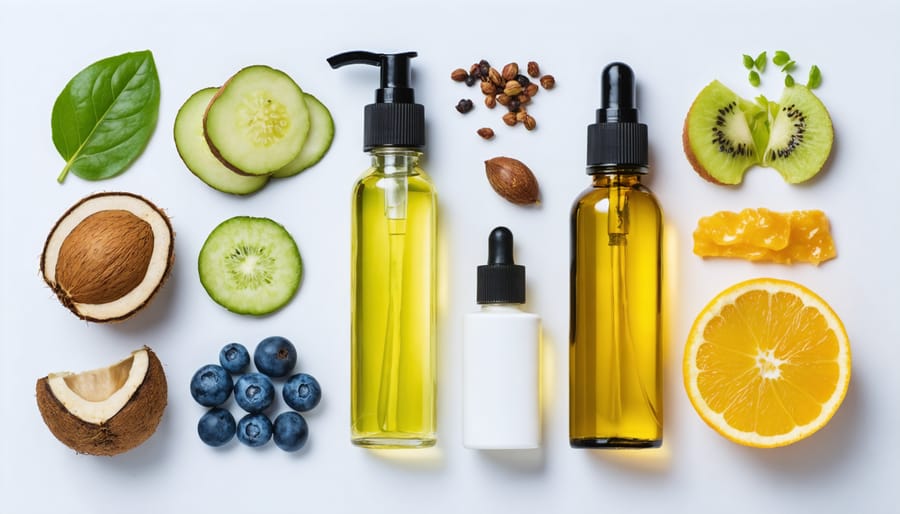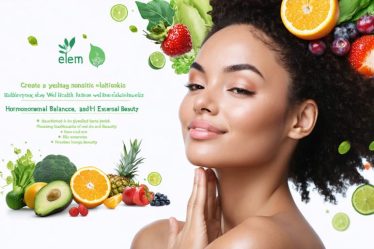
Discover the beauty industry’s best-kept secret: inulin, a prebiotic powerhouse revolutionizing skincare from the inside out. This natural fiber, extracted from chicory root and other plants, doesn’t just nourish your beneficial skin bacteria—it transforms your complexion by strengthening your skin barrier, reducing inflammation, and promoting a healthy microbiome. While you might know inulin as a dietary supplement, its topical applications are proving to be a game-changer for those seeking balanced, radiant skin.
Think of inulin as your skin’s personal gardener, cultivating the perfect environment for good bacteria to thrive while keeping harmful organisms at bay. This gentle yet effective ingredient works particularly well for sensitive and reactive skin types, offering deep hydration without the irritation commonly associated with traditional active ingredients. Whether you’re dealing with dryness, redness, or simply wanting to upgrade your skincare routine, inulin’s science-backed benefits make it a must-have ingredient in your beauty arsenal.
The Science Behind Inulin’s Skin-Loving Properties
From Prebiotic to Skin Food
Just like a garden needs the right soil conditions to flourish, your skin needs a balanced environment to thrive. That’s where inulin comes in – it’s not just any skincare ingredient, but a powerful prebiotic that feeds the good bacteria living on your skin. Think of it as serving up a gourmet meal to your skin’s microscopic helpers!
When applied topically, inulin acts like a nurturing friend to your skin’s microbiome, supporting the growth of beneficial bacteria while keeping the troublemakers in check. It works by providing these friendly microorganisms with their favorite food source, helping them multiply and create a stronger protective barrier on your skin.
I’ve noticed in my own skincare journey that products with inulin have helped maintain that coveted “healthy glow” we all love. The secret lies in how it supports your skin’s natural ecosystem – when your microbiome is happy and balanced, your skin shows it! It helps maintain optimal pH levels and strengthens your skin’s natural defense system, making it more resilient against environmental stressors.
The best part? This prebiotic superstar is gentle enough for all skin types, working quietly behind the scenes to promote that natural, healthy radiance we’re all after.

The Moisture-Locking Magic
Think of inulin as your skin’s personal moisture magnet. This remarkable ingredient acts like a protective shield, helping your skin retain its natural hydration while strengthening its barrier function. I discovered its magic when battling dry winter skin, and the transformation was nothing short of amazing!
What makes inulin so special is its ability to form a breathable film on your skin’s surface. This film doesn’t just lock in moisture – it creates the perfect environment for your skin’s beneficial bacteria to thrive, promoting a healthy microbiome. Imagine having a protective force field that keeps the good stuff in and the bad stuff out!
The best part? Inulin works for all skin types, from sensitive to combination. It’s particularly fantastic for those dealing with dehydration or a compromised skin barrier. When combined with other hydrating ingredients, it creates a powerful moisture-boosting cocktail that leaves your skin feeling plump, soft, and naturally radiant.
As someone who’s tried countless hydrating products, I can tell you that inulin-based formulations offer that perfect balance – they’re deeply hydrating without feeling heavy or greasy.
Kitchen-to-Vanity: DIY Inulin Skincare Recipes
Soothing Inulin Face Mask
Ready to pamper your skin with the goodness of inulin? This DIY face mask combines some of my favorite natural beauty ingredients to create a soothing, nourishing treatment that’s perfect for a self-care Sunday.
Ingredients:
– 2 tablespoons chicory root powder (rich in inulin)
– 1 tablespoon honey
– 1 tablespoon plain yogurt
– 3-4 drops lavender essential oil (optional)
Instructions:
1. In a small bowl, combine the chicory root powder and honey until well mixed
2. Add yogurt and stir to create a smooth paste
3. If desired, add lavender essential oil for extra relaxation benefits
4. Cleanse your face thoroughly
5. Apply the mask evenly across your face, avoiding the eye area
6. Leave on for 15-20 minutes
7. Rinse with lukewarm water using gentle circular motions
8. Follow with your favorite moisturizer
I love using this mask once a week to give my skin that extra boost of hydration. The inulin helps lock in moisture while the probiotics in yogurt and antibacterial properties of honey work together to create a naturally glowing complexion. Pro tip: Keep the mixture in the fridge for 5-10 minutes before applying for an extra refreshing sensation!
Remember to patch test any new skincare recipe on a small area first, especially if you have sensitive skin.

Prebiotic Skin Toner
Ready to pamper your skin with a gentle, prebiotic-rich toner? I’m excited to share my favorite DIY recipe that’s been a game-changer for my skincare routine. This natural toner combines the power of inulin with other skin-loving ingredients to help balance and nourish your complexion.
You’ll need:
– 1 tablespoon inulin powder
– 1 cup distilled water
– 1 tablespoon organic rose water
– 1 teaspoon glycerin
– 2-3 drops of lavender essential oil (optional)
Start by heating the distilled water until warm (not boiling). Dissolve the inulin powder in the warm water, stirring gently until fully incorporated. Once the mixture has cooled to room temperature, add the rose water and glycerin. If desired, add the lavender essential oil for a calming aromatherapy boost.
Pour your toner into a clean, dark glass bottle with a spray top or flip cap. Store in a cool, dark place and use within 2-3 weeks. To use, simply apply to clean skin using a cotton pad or spray directly onto your face morning and night.
This gentle formula helps maintain your skin’s microbiome while providing light hydration. You might notice your skin feeling softer and looking more balanced within a few days of regular use. Remember, everyone’s skin is different, so always patch test new products before applying them to your entire face.
Incorporating Inulin into Your Beauty Routine
Daily Skincare Integration
Incorporating inulin into your personalized skincare routine doesn’t have to be complicated. Start by checking the ingredients list of your current products – you might already be using inulin without realizing it! Look for terms like “chicory root extract” or “inulin” on the label.
For those new to inulin skincare, begin by introducing one inulin-containing product at a time. A gentle cleanser or moisturizer is an excellent starting point. Apply these products to slightly damp skin to maximize absorption and benefits. If you’re using multiple products with inulin, layer them from thinnest to thickest consistency.
Here’s a simple way to integrate inulin throughout your day:
– Morning: Use an inulin-infused face wash followed by a light moisturizer
– Afternoon: Spritz with an inulin-based facial mist for hydration
– Evening: Apply a richer inulin cream or overnight mask
Remember to patch test new products on a small area of skin first, especially if you have sensitive skin. Give your skin time to adjust – about two weeks – before evaluating results. And don’t forget that skincare benefits are often enhanced when combined with a healthy diet that includes prebiotic-rich foods!
Shopping Smart for Inulin Products
When shopping for inulin-infused skincare products, it’s essential to become a savvy label reader. Trust me, I’ve learned this through plenty of trial and error! Look for products that list inulin or chicory root extract in the first half of the ingredients list – this usually indicates a higher concentration of the good stuff.
You’ll often find inulin in moisturizers, serums, and face masks, where its hydrating properties can really shine. But here’s a pro tip: check if the product also contains complementary ingredients like hyaluronic acid or ceramides, which work beautifully alongside inulin to boost its effectiveness.
Keep an eye out for terms like “prebiotic skincare” or “microbiome-friendly” on packaging, as these often indicate the presence of inulin. However, don’t be fooled by vague marketing claims about “natural prebiotics” without specific ingredients listed.
Price points can vary widely, but remember that a higher price tag doesn’t necessarily mean better quality. I’ve found some fantastic mid-range products that deliver excellent results. Start with smaller sizes when trying new products, and pay attention to packaging that protects the formula from light and air exposure, as this helps maintain the ingredients’ effectiveness.

Inside-Out Beauty: Eating Your Way to Better Skin
We all know the saying “you are what you eat,” and when it comes to skin health, this couldn’t be more true. Just as topical inulin can work wonders for your skin, consuming this prebiotic fiber can help nourish your skin from within, creating a beautiful inside-out effect.
I discovered this game-changing connection during my own wellness journey, and let me tell you, the results were absolutely worth the small dietary tweaks! Inulin-rich foods like chicory root, Jerusalem artichokes, and bananas don’t just support your gut health – they create a ripple effect that shows up right on your face.
Here’s how it works: when you consume inulin, it feeds the beneficial bacteria in your gut, helping create a balanced microbiome. This balance reduces inflammation throughout your body, including your skin, and helps regulate hormones that can affect everything from acne to collagen production.
The best part? You don’t need to completely overhaul your diet. Start small by adding a handful of chicory root to your morning smoothie or snacking on banana chips. Your gut bacteria will thank you, and your skin will show its appreciation through that coveted natural glow we’re all after.
Remember, consistent small changes lead to the most sustainable results. As your body adjusts to increased fiber intake, you’ll notice improvements not just in your skin, but in your overall well-being too.
As we’ve explored, inulin is truly a game-changer in the world of skincare. This natural prebiotic not only supports your skin’s microbiome but also helps maintain moisture, reduce inflammation, and promote a healthy, glowing complexion. Whether you’re dealing with sensitivity, dryness, or simply want to enhance your skincare routine, inulin-based products offer a gentle yet effective solution. I’ve personally noticed a significant improvement in my skin’s texture and balance since incorporating inulin skincare into my daily routine, and I’m confident you will too. Ready to give your skin the prebiotic boost it deserves? Start small by introducing one inulin-infused product into your regimen and watch as your skin transforms. Remember, healthy skin starts from within, and inulin is your perfect partner in achieving that natural, radiant glow we all desire.



